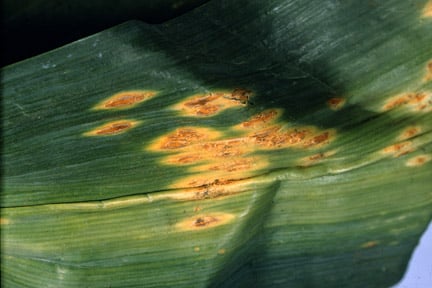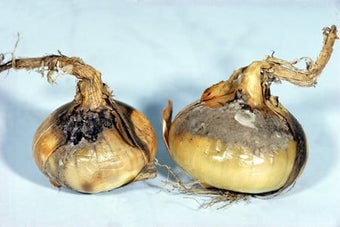
Quick facts
Common name - Leek rust
Scientific name - Puccinia porri (syn. Puccinia allii)
Plants affected - Leeks, onions, garlic and chives
Main symptoms - Bright orange pustules on leaves
Caused by - Fungus
Timing - Mid-summer until late autumn
What is leek rust?
Leek rust is a disease caused by the fungus Puccinia porri (syn. P. allii). It is important on leeksand garlic but also affects onions, chives and other Allium spp. The rust pathogen is comprised of distinct sub-groups which differ in different parts of the world. In the UK onions are rarely severely affected, but rust can be serious on leek, garlic and chives. Work at the RHS suggests that the form that infects leeks does not infect chives and vice versa, but that garlic is susceptible to both types. Most attacks occur from mid-summer until late autumn.
Symptoms
You may see the following symptoms:
- On leaves: Bright orange pustules on both sides of infected leaves. These are initially enclosed by the surface tissues of the leaf, but break open to release dusty, orange, airborne spores
- Severe attacks may cause leaves to shrivel prematurely and will reduce vigour
Control
Non-chemical control
- Infection is worse on nitrogen-rich soils with low potassium, so take care with fertiliser applications
- Do not crowd plants, as this raises and increases the likelihood of infection
- Dispose of all plant debris at the end of cropping
- Suppliers sometimes claim a degree of resistance for certain varieties, check the latest catalogues for those currently available
Chemical control
There are no fungicides approved for use by amateur gardeners to control leek rust.
Biology
The rust fungi are described as biotrophs; that is, they grow within the living tissues of the plant and extract from the cells without killing them. However, although they do not kill tissues, heavy attacks by rusts can cause the leaves to shrivel and die prematurely and can depress vigour.
Rusts are not able to survive in an active state on dead plant material, so those affecting must either alternate with a different, host, or produce resting spores to pass the season.
The leek rust pathogen seems to fulfil its entire life cycle on leeks, without the need for an alternate host. On some other Allium species the fungus begins to produce dark resting spores within the orange pustules as the foliage dies down. These resting spores have been observed occasionally on leeks, but the role that they play in the disease on this crop is currently unknown. It is likely that there are simply sufficient leeks in the ground at all times of the year to ensure continuity of infection, without the need for resting spores.
Puccinia porri (syn. P. allii) has been confirmed as being seed-borne, but this is not currently thought to be of any great significance in the spread of the disease.
It is thought that a number of strains of P. porri (syn. P. allii) exist, varying in their ability to infect different Allium species.




